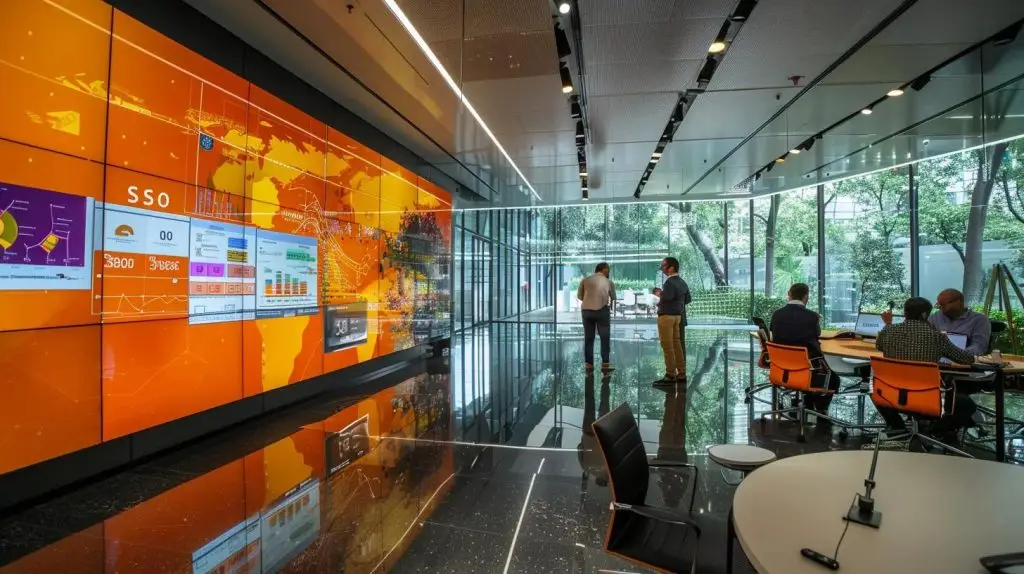ISO Compliance Framework: A Blueprint for Security Excellence
How ISO Compliance Framework Elevates Organizational Security
In today’s fast-changing security landscape, organizations are increasingly forced to adopt robust frameworks, including managed-it-services, that not only protect data and systems but also build trust with stakeholders. An ISO compliance framework offers this dual advantage by outlining rigorous security standards, risk management processes, and continuous improvement strategies. Many organizations now leverage database-managed-services to ensure that ISO standards provide a systematic approach to assessing vulnerabilities, implementing safeguards, and demonstrating accountability to external regulators, partners, and sheep-dog-vciso. Organizations that achieve compliance can streamline audits, minimize risks, and attain a competitive edge in the market.
ISO compliance frameworks also serve as a strategic tool for aligning an organization’s security practices with international best practices. This alignment not only facilitates enhanced data protection but also supports organizational growth by ensuring that systems and processes remain resilient in the face of emerging threats. The framework’s systematic approach—from establishing core principles to the ongoing monitoring and refinement of processes—creates a culture of security that permeates every level of the enterprise, from leadership to operational staff. In this article, we explore the details of how an ISO compliance framework elevates organizational security by defining its structure, examining its benefits, addressing risk management, and outlining actionable implementation phases.
Transitioning from this overview, the following key takeaways summarize the critical elements of ISO compliance frameworks and their role in bolstering security.

Key Takeaways
- ISO compliance frameworks provide a structured approach to establishing, monitoring, and improving security practices.
- They incorporate international standards such as ISO 27001, ISO 27701, and ISO 22301, ensuring consistent application worldwide.
- Effective risk management, ongoing internal reviews, and leadership support are pivotal for sustained security enhancement.
- The framework not only safeguards sensitive data but also fortifies network defenses and prepares organizations for evolving threats.
- Adopting these standards can result in a competitive advantage and improved trust among customers and business partners.

Defining the ISO Compliance Framework for Organizational Security
ISO compliance frameworks are designed to set a clear standard for organizational security and inform consistent security practices across all operational levels. At its core, the framework provides guidelines and best practices that help organizations achieve and maintain high standards of data protection, process efficiency, and regulatory compliance.
Core Principles Guiding an ISO Security Standard
The principles behind ISO security standards rest on transparency, accountability, and continuous improvement. These include establishing clear scopes for information security, ensuring risk management processes are robust, and guaranteeing that roles and responsibilities for security are well delineated. By adhering to these fundamental principles, organizations can support the creation of secure environments that not only protect personal data and intellectual property but also build stakeholder confidence. These principles drive decision making, ensuring each security measure is both justified and integrated into the broader security architecture.
How an ISO Framework Establishes Foundational Security Measures
ISO frameworks guide organizations through a structured process starting with riskevaluation and stakeholder analysis. This process involves identifying assets, assessing vulnerabilities, and determining the potential impact of security breaches. Once risks are identified, organizations can then prioritize mitigation measures, thereby establishing a foundational security posture that includes robust configurations, regular system updates, and comprehensive training for staff. These measures help ensure that both the physical and cyber realms within an organization are fortified against attacks.
The Function of ISO Standards in Global Security Alignment
ISO standards allow organizations to align their security practices with internationally recognized benchmarks. This global alignment is essential in a connected world where data flows seamlessly across borders. It also simplifies the auditing process for multinational corporations and enhances trust among international partners. By adopting an ISO framework, companies benefit from an internationally vetted set of security practices that promote consistency, reliability, and interoperability across diverse regulatory environments.
Differentiating Compliance and Certification Within an ISO Structure
A critical feature of the ISO framework is understanding the distinction between being compliant and obtaining certification. Compliance refers to the internal adherence to ISO guidelines, while certification is an external validation that an organization’s practices meet these standards. Certification by an accredited body provides a competitive advantage by displaying a tangible commitment to security excellence. Organizations must therefore not only implement the framework internally but also undergo rigorous external audits to achieve certification.

Attaining Enhanced Security Through an ISO Compliance Framework
Attaining enhanced security within an organization begins with a deep commitment to structured ISO compliance measures. By integrating the framework at every level—from technological infrastructure to operational procedures—the organization ensures a continuous cycle of review, improvement, and reinforcement of its security practices.
Instituting Robust Access Controls With ISO Directives
Access control is a cornerstone of any secure environment, and ISO directives provide precise guidelines to ensure that only authorized individuals gain access to sensitive information. Organizations are required to implement measures such as multi-factor authentication, strict password policies, and regular review of access permissions. These access controls reduce the likelihood of insider threats and unauthorized access, thereby protecting critical assets from breaches that could compromise sensitive data.
Safeguarding Data Integrity and Confidentiality Using ISO Protocols
Data integrity and confidentiality are maintained through standardized procedures that govern how data is stored, processed, and transmitted across networks. ISO protocols emphasize encryption, secure communication channels, and rigorous data handling procedures. By implementing these practices, companies can ensure that any unauthorized modifications or accesses are promptly identified and mitigated, thus preserving the trust essential for operational continuity. In addition, periodic audits help in verifying that these protocols remain effective even in the face of evolving cyber threats.
Refining Incident Response Capabilities With an ISO System
An effective incident response plan is vital to mitigating the effects of potential security breaches. ISO compliance frameworks provide detailed strategies for identifying, reporting, and analyzing incidents when they occur. This includes predefined communication plans, emergency response actions, and crisis management procedures to minimize damage and restore normal operations swiftly. The structured approach to incident response ensures that all stakeholders are well-informed and decisive action is taken to quell any emerging threats.
Fostering a Security-Conscious Culture via ISO Framework Adoption
The strength of an ISO compliance framework is significantly enhanced by its impact on organizational culture. By embedding security-conscious practices into daily operations, organizations cultivate an environment where every employee understands the importance of data protection. Regular training programs, awareness campaigns, and clear communication channels foster a culture of vigilance. This cultural shift ensures that security is a shared responsibility, enhancing the overall resilience of the organization against both internal and external threats.
How an ISO Compliance Framework Bolsters Network Defenses
Network defenses are a critical element in preventing cyber-attacks. Through a combination of firewalls, intrusion detection systems, and continuous monitoring, ISO frameworks help organizations build robust protection mechanisms. These network defenses work in concert with other ISO-mandated practices to ensure that any attempted breach can be detected and thwarted before reaching sensitive data. By establishing layered security measures, organizations can reduce the potential attack surface and enhance overall network resilience.

Methodically Addressing Risks With an ISO Compliance Framework
Effective risk management is central to an ISO compliance framework. By systematically addressing risks, organizations can identify vulnerabilities early, establish appropriate countermeasures, and continuously monitor for potential threats. This structured approach enables proactive management of risks rather than reactive responses to breaches.
Pinpointing and Evaluating Vulnerabilities Through ISO Methodologies
The first step in addressing risks involves a comprehensive vulnerability assessment using standardized ISO methodologies. This process includes detailed inspections of information systems, hardware, and operational procedures to detect weaknesses. Organizations then evaluate the potential impact of these vulnerabilities, often quantifying the risk with measurable parameters. This identification and evaluation phase is critical, as it forms the foundation for all subsequent risk treatment strategies and helps prioritize resource allocation toward the most significant threats.
Creating Risk Treatment Strategies Consistent With ISO Standards
Upon identifying vulnerabilities, organizations must develop risk treatment strategies that align with ISO guidelines. These strategies involve mitigating, transferring, or accepting risks based on their assessed severity and potential impact. For example, high-impact risks may warrant investment in advanced cybersecurity technologies, while lower-impact risks might be mitigated through regular system updates and employee training. By adopting a structured risk treatment plan, organizations can ensure that potential threats are addressed proactively and resources are allocated efficiently.
Sustained Risk Observation Within an ISO Management System
Risk management is not a one-time exercise; it requires continuous observation and review. ISO management systems mandate regular audits, monitoring, and updates to ensure that the risk management strategies remain effective over time. This sustained observation involves monitoring for emerging threats, re-assessing vulnerabilities, and updating mitigation measures as necessary. Continuous monitoring supports an adaptive security posture that can evolve with changing technologies and threat landscapes.
Diminishing the Probability and Effects of Security Breaches
By incorporating a layered risk management approach, organizations can significantly reduce both the likelihood and impact of security breaches. The ISO framework provides specific guidelines for implementation of protective technologies and processes that attenuate risks. Moreover, the systematic documentation of incidents and lessons learned reinforces the organization‘s ability to anticipate, mitigate, and recover from breaches in a timely manner, ensuring minimal disruption to business operations.
Recording Risk Management Procedures for ISO Adherence
Documentation is a critical element of risk management. Under ISO guidelines, organizations must meticulously record all risk management procedures, incident responses, corrective actions, and audit results. This documentation not only aids in internal reviews but also serves as evidence during external audits or certification processes. A detailed log of risk management activities helps maintain transparency and demonstrates the organization’s commitment to security, making it easier to identify trends and implement continuous improvements.

Key ISO Standards Within a Security Compliance Framework
ISO standards underpin the effectiveness of a comprehensive security compliance framework. These standards set the benchmarks for managing risks, protecting data, and ensuring business continuity globally. They enable organizations to adopt a unified approach to security that meets both national and international regulatory requirements.
Comprehending ISO 27001 for Information Security Management Systems
ISO 27001 is the cornerstone for designing and implementing an information security management system (ISMS). This standard outlines a risk-based approach to securing sensitive information and establishes a systematic process for managing security risks. Adherence to ISO 27001 ensures that an organization implements adequate safeguards, continuous monitoring, and regular audits, which in turn facilitate the preservation of data confidentiality, integrity, and availability. Organizations that comply with ISO 27001 often experience a reduction in data breaches, improved customer trust, and enhanced regulatory compliance.
Utilizing ISO 27701 for Privacy Information Management Systems
As data privacy becomes increasingly crucial, ISO 27701 extends the principles of ISO 27001 to privacy management. This standard helps organizations establish, maintain, and continually improve a privacy information management system (PIMS). By adopting ISO 27701, organizations can manage personal data in line with global regulations such as the GDPR, ensuring that privacy risks are identified, assessed, and mitigated effectively. This standard supports a balanced approach to maintaining user privacy while still enabling the organization to achieve its operational goals.
Employing ISO 22301 for Business Continuity Planning
Business continuity planning is essential for mitigating the impact of disruptive events. ISO 22301 provides a framework for developing, implementing, and maintaining effective business continuity plans. It ensures that organizations can quickly recover from incidents such as cyber-attacks, natural disasters, or systemic failures with minimal disruption to operations. With ISO 22301, companies not only secure their data but also safeguard the integrity of critical processes, thereby enhancing overall organizational resilience.
How Various ISO Standards Interlink for Total Security Coverage
The interplay between different ISO standards creates a comprehensive security ecosystem that addresses all facets of organizational security. While ISO 27001 focuses on information security, ISO 27701 integrates privacy management, and ISO 22301 covers business continuity planning. Together, these standards form a synergistic approach that ensures every element—from data handling to crisis management—is aligned under one cohesive framework. This interlinking results in a robust, multi-layered defense mechanism that protects the organization on multiple fronts.

Actionable Stages to Implement a Successful ISO Compliance Framework
Implementing an ISO compliance framework is a multi-stage process that requires careful planning, leadership involvement, and continuous monitoring. Each phase of implementation builds on previous steps to create a secure and resilient organizational environment. The following actionable stages provide a roadmap to guide organizations through effective ISO compliance, ensuring that each critical element is addressed and documented.
Obtaining Leadership Backing for ISO Program Initiation
The success of any ISO compliance framework begins with the commitment of the organization’s leadership. Strong executive backing is essential for allocating necessary resources, driving cultural change, and setting security as a strategic priority. Leadership support not only legitimizes the initiative but also fosters an environment where every employee understands the importance of following security protocols. When leaders actively participate in and champion ISO compliance, it creates a cascading effect that promotes organization-wide investment in security measures.
Performing a Discrepancy Analysis Against a Selected ISO Standard
A thorough discrepancy analysis is fundamental before embarking on the implementation process. This analysis involves comparing current security practices against the chosen ISO standard to identify gaps and areas needing improvement. By conducting a systematic review, organizations can pinpoint the discrepancies between existing practices and the requirements of the standard. This process helps clarify the steps needed to achieve full compliance, ensuring that enhancements are targeted, measurable, and aligned with international best practices.
Formulating and Documenting Security Policies and Operational Steps
Once gaps have been identified, organizations must develop clear and concise security policies that define operational requirements in line with ISO standards. This documentation process involves drafting policies that cover all aspects of data protection, access controls, incident response, and continuous monitoring. Detailed documentation not only serves as a blueprint for daily operations but also aids in training staff and during external audits. Comprehensive policies ensure that the organization can consistently replicate and enforce best security practices across all departments.
Educating Staff on ISO Stipulations and Security Best Practices
For an ISO compliance framework to be effective, all employees must understand its requirements and the rationale behind each policy. Training programs should be established to educate staff on the nuances of the ISO standards, risk management procedures, and incident response protocols. Regular workshops, simulations, and refresher courses help keep security practices top of mind and ensure that employees can swiftly adapt to any changes in policies or external threats. By fostering informed and vigilant staff, organizations can significantly reduce the risk of human error-induced breaches.
Gearing Up for and Completing an ISO Certification Assessment
The final stage of implementation involves preparing for an external audit that will verify the organization‘s compliance with the selected ISO standard. This certification assessment is a rigorous process that examines the documented policies, risk management practices, and overall effectiveness of the implemented security measures. Organizations must ensure that all documentation is up-to-date and that staff are prepared to answer audit inquiries confidently. Achieving certification not only validates the organization‘s security posture but also serves as a testament to clients, partners, and regulators of its commitment to robust security practices.

Preserving and Progressing Security With Your ISO Compliance Framework
Achieving ISO certification is not the end of the security journey; it is merely a milestone in a continuous process of improvement. Once an organization has implemented its ISO compliance framework, maintaining and advancing security practices is essential to combat evolving threats and organizational changes. Continuous review, assessment, and adaptation form the bedrock of long-term security resilience.
Carrying Out Periodic Internal Reviews for Continuous ISO Conformity
Regular internal reviews are crucial to ensure ongoing adherence to ISO standards. Organizations should establish scheduled reviews and audits to assess the effectiveness of their security measures and identify any gaps or areas for improvement. These periodic assessments enable firms to compare current practices with evolving best practices and adjust policies accordingly. By continuously monitoring and documenting compliance efforts, organizations can swiftly respond to internal and external audits while maintaining a high level of security.
Applying Remedial Actions and Proactive Safeguards
When discrepancies or vulnerabilities are identified during internal reviews, organizations must promptly implement remedial actions. This approach involves not only correcting existing deficiencies but also taking steps to prevent their recurrence. Proactive safeguards, such as advanced monitoring tools, training updates, and process reinforcements, ensure that riskmitigation strategies remain effective over time. A proactive stance helps minimize downtime and reduce the potential impact of security breaches, ultimately contributing to a culture of continuous improvement.
The Leadership Review Procedure in an ISO Security Context
Periodic leadership reviews form an integral part of sustaining a robust ISO compliance framework. Senior management should regularly evaluate the overall security posture, reviewing risk assessments, incident reports, and compliance metrics. These reviews enable leaders to make informed decisions regarding resource allocation, policy adjustments, and strategic direction. Transparent leadership reviews ensure that the organization remains aligned with its long-term security goals and that all levels of the organization are held accountable for maintaining high standards.
Modifying Your ISO Framework for Emerging Threats and Organizational Shifts
The threat landscape is dynamic, and so too should be an organization’s ISO compliance framework. As new risks emerge and the business environment evolves, it is essential to update the framework accordingly. This might involve integrating new technologies, adopting additional standards, or revising procedures to address specific vulnerabilities. By remaining agile and responsive to change, organizations can mitigate potential threats before they escalate into significant security incidents.
Aiming for Persistent Refinement in Organizational Security Practices
Continuous improvement is a central tenet of ISO compliance. Organizations should set long-term goals for refining their security practices and use metrics, feedback, and technological advancements as benchmarks for progress. Embracing a philosophy of persistent refinement not only enhances security but also promotes innovation and efficiency across all operational processes. This commitment to excellence ensures that the organization stays ahead of cyber threats, regulatory changes, and competitive pressures while cultivating a secure, resilient environment.

Final Thoughts
ISO compliance frameworks are vital to enhancing organizational security by setting robust, internationally recognized standards. This article has demonstrated how these frameworks offer structured guidance that encompasses everything from risk management and access controls to employee training and continuous improvement. The comprehensive approach of ISO standards not only safeguards critical data and infrastructure but also builds a resilient foundation for future growth. Organizations that fully embrace these frameworks achieve a higher degree of trust, operational efficiency, and competitive advantage.

Frequently Asked Questions
Q: What is an ISO compliance framework? A: An ISO compliance framework is a structured set of guidelines and best practices designed to help organizations manage and improve their security protocols in accordance with international standards, reducing risks and protecting sensitive information.
Q: How does ISO 27001 contribute to information security? A: ISO 27001 provides a risk-based process for establishing, implementing, and continually improving an information security management system, ensuring that organizations protect their data through systematic risk assessments and ongoing internal audits.
Q: What role does employee training play in ISO compliance? A: Employee training is critical because it ensures that all staff members understand and adhere to security practices outlined in the ISO framework. Regular training keeps security protocols top-of-mind and helps prevent potential breaches from human error.
Q: How does an organizationmaintain continuous ISO compliance? A: Organizations maintain continuous compliance through periodic internal reviews, monitoring, and adapting their security policies to address emerging threats. This includes regular audits and leadership reviews to ensure alignment with evolving security standards.
Q: Can ISO compliance enhance network defenses? A: Yes, ISO compliance enhances network defenses by implementing layered security measures, such as robust access controls, continuous monitoring, and advanced incident response protocols, which collectively reduce the vulnerability to cyber-attacks and data breaches.




